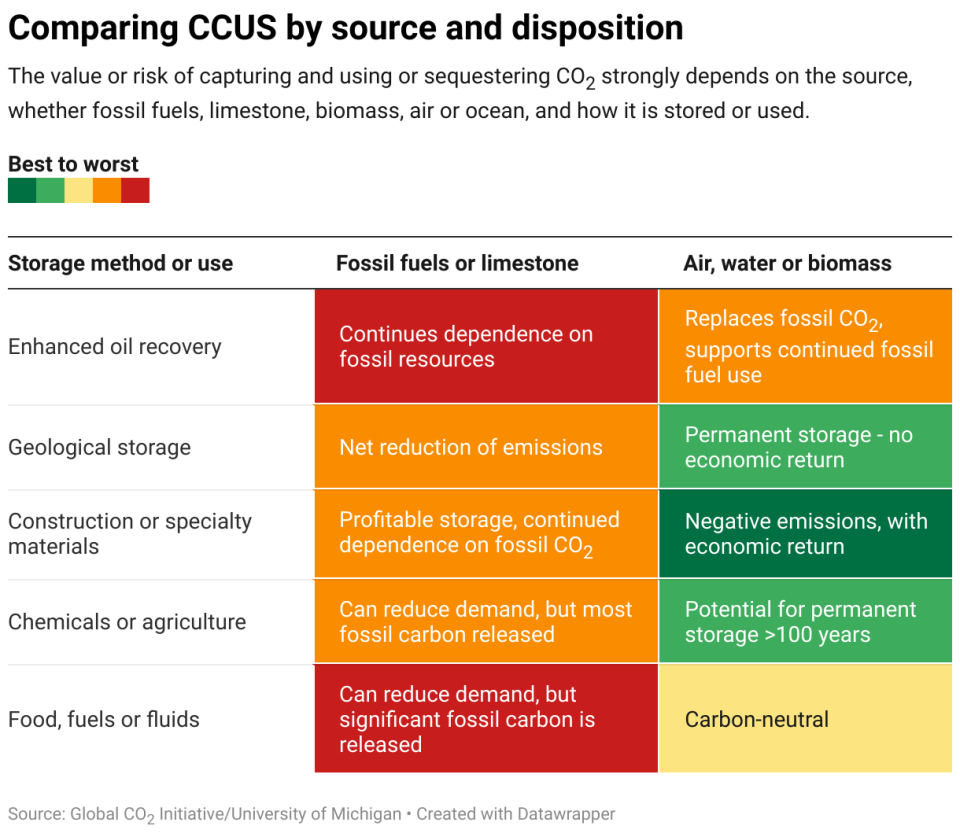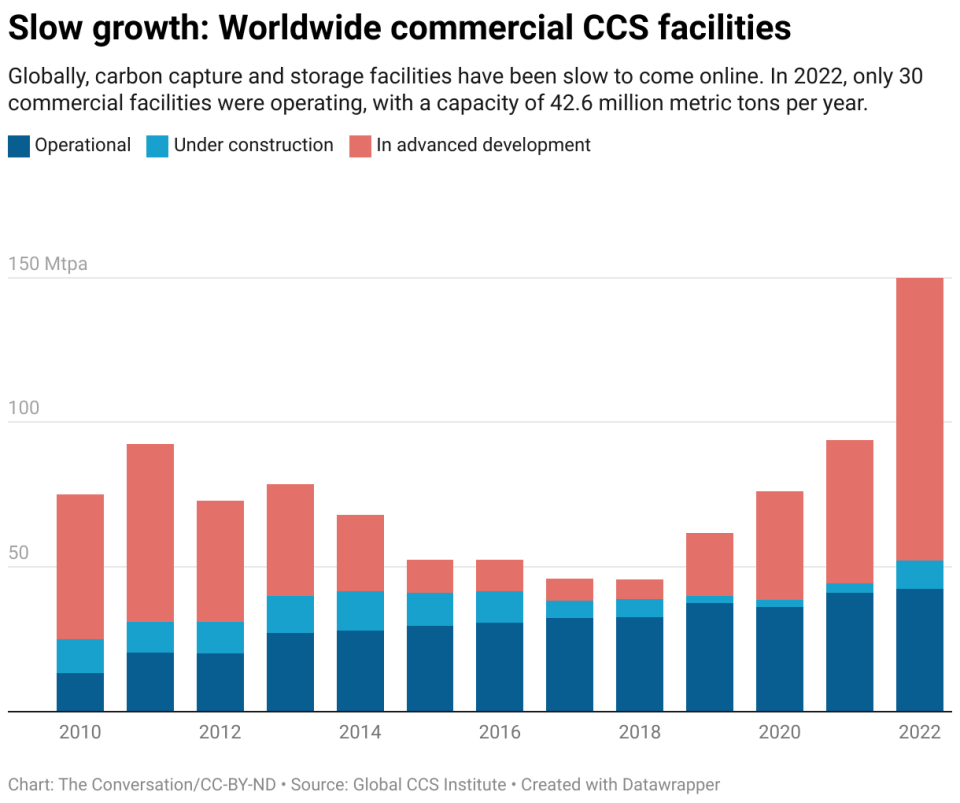Capturing carbon dioxide from the air or industries and recycling it may seem like a win-win climate solution. Greenhouse gas is kept out of the atmosphere, where it can warm the planet, and prevents the use of more fossil fuels.
But not all carbon capture projects offer the same economic and environmental benefits. In fact, some may make climate change worse.
I direct the Global CO₂ Initiative at the University of Michigan, where my colleagues and I study how to use captured carbon dioxide (CO₂) in ways that help protect the climate. To help determine which projects will come to fruition and make these decisions easier, we map out the pros and cons of the most common carbon sources and uses.
Replace fossil fuels with captured carbon
Carbon plays a crucial role in many parts of our lives. Materials such as fertilizers, aviation fuel, textiles, detergents and much more depend on it. But years of research and the climate changes the world is already experiencing have made it abundantly clear that humanity urgently needs to end the use of fossil fuels and remove the excess CO₂ from the atmosphere and oceans that has resulted from their use.
Some carbon materials can be replaced with carbon-free alternatives, such as using renewable energy to produce electricity. However, for other uses, such as aviation fuel or plastics, carbon will be harder to replace. For these, technologies are being developed to capture and recycle carbon.
Capturing excess CO₂ (from the oceans, atmosphere or industry) and using it for new purposes is called carbon capture, utilization and sequestration, or CCUS. Of all the options for managing captured CO₂, my colleagues and I prefer to use it to make products, but let’s look at them all.
Best and worst cases of CCUS
With each method, the combination of the source of the CO₂ and its end use or disposal determines its environmental and economic consequences.
In the best case, the process will leave less CO₂ in the environment than before. A good example of this is the use of captured CO₂ to produce construction materials, such as concrete. It seals in the captured carbon and creates a product that has economic value.

Some methods are carbon neutral, meaning they add no new CO₂ to the environment. For example, when CO₂ captured from the air or oceans is used and converted into fuel or food, the carbon returns to the atmosphere, but using the captured carbon avoids the need for new carbon from fossil fuels.
Other combinations, however, are harmful because they increase the amount of excess CO₂ in the environment. One of the most common underground storage methods – enhanced oil recovery – is a prime example.
Pros and cons of underground carbon storage
For years, projects have been capturing excess CO₂ and storing it underground in natural porous rock structures, such as deep saline reservoirs, basalt, or depleted oil or gas wells. This is called carbon capture and sequestration (CCS). If done correctly, geological storage can lastingly remove large amounts of CO₂ from the atmosphere.
When CO₂ is captured from air, water or biomass, a negative carbon process is created: there is then less carbon in the air. However, if the CO₂ comes from new fossil fuel emissions, such as those from a coal or gas-fired power plant, carbon neutrality is not possible. No carbon capture technology works at 100% efficiency and some CO₂ will always escape into the air.
CO₂ capture is also expensive. If there is no product to sell, underground storage can become an expensive service ultimately covered by taxes or fees, similar to paying for garbage removal.




One way to reduce the cost is to sell captured CO₂ to enhance oil recovery, a common practice that pumps captured CO₂ to oil fields to extract more oil from the ground. While most of the CO₂ is expected to stay underground, the result is that more fossil fuels will eventually send more carbon dioxide into the atmosphere, eliminating the environmental benefit.
Using captured carbon for food and fuel
Short-lived materials made from CO₂ include aviation fuels, foods, medications, and working fluids used in metal machining. These items are not particularly durable and will soon decompose, releasing CO₂ again. But the sale of the products generates economic value and helps pay for the process.
This CO₂ can be captured again from the air and used to make a future generation of products, creating a sustainable and essentially circular carbon economy. However, this only works if the CO₂ is captured from the air or oceans. If the CO₂ comes from fossil fuel sources, this is new CO₂ that will be added to the environment when the products decompose. So even if it is recaptured, it will make climate change worse.
Carbon storage in materials, such as concrete.
Some minerals and waste materials can convert CO₂ into limestone or other rock materials. Durable materials created in this way can be very durable, with lifespans exceeding 100 years.
A good example is concrete. CO₂ can react with concrete particles and cause them to mineralize into solid form. The result is a useful product that can be sold instead of stored underground. Other durable products include aggregates used in road construction, carbon fiber used in automotive, aerospace and defense applications, and some polymers.
These materials provide the best combination of environmental impact and economic benefit when made with CO₂ captured from the atmosphere instead of new fossil fuel emissions.
Choose your carbon projects wisely
CCUS can be a useful solution and governments have begun investing billions of dollars in its development. It must be closely monitored to ensure that carbon capture technologies do not delay the phase-out of fossil fuels. It is an effort by all involved to take the best combinations of sources and disposal of CO₂ to achieve rapid scale-up at an affordable cost to society.
Given that climate change is such a complex issue that is harming people around the world, as well as future generations, I believe it is imperative that actions are not only swift, but also well thought out and evidence-based.
Fred Mason, Gerry Stokes, Susan Fancy, Kristi Kattapong and Stephen McCord of the Global CO₂ Initiative contributed to this article.
This article is republished from The Conversation, an independent, nonprofit news organization bringing you data and analysis to help you understand our complex world.
It was written by: Volker Sick, University of Michigan.
Read more:
Volker Sick receives funding from the Grantham Foundation for the Preservation of the Environment.